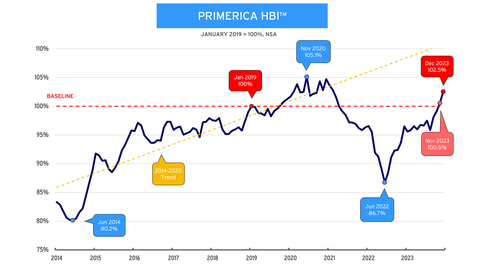SURVEY: Middle-Income Americans Split on Outlook for Personal Finances
Purchasing power reaches highest levels since
This press release features multimedia. View the full release here: https://www.businesswire.com/news/home/20240130269021/en/

Primerica Household Budget Index™ (HBI™) - In
“While the Consumer Price Index (CPI) saw a jump of 3.3% in December, middle-income families saw a much lower increase in the cost of necessities at 1% over last year,” said
Key Household Budget Index™ Findings
In
“As we head into 2024, we’re seeing improvements in the financial well-being of middle-income households as the cost of necessities like gasoline and heating fuel decline and they experience real, inflation-adjusted income gains,” said
Key Findings from Primerica’s
The latest FSM™ survey data shows that exactly half (50%) of middle-income families report their personal financial situation as being positive. While this positive sentiment was higher in
- Middle-income Americans continue to be split in their assessment of their personal finances. Exactly half (50%) say their personal financial situation is excellent or good, with the other half saying it is either not so good or poor. In addition, a large majority (80%) are as concerned or more concerned about their credit card debt today compared to a year ago, and two-thirds (66%) don’t know the interest rate for their credit cards.
-
Majority of middle-income Americans remain pessimistic about the state of the economy. Overall, three-fifths (60%) are pessimistic about the economy over the next year. Broken out by age group, this includes nearly two-thirds (63%) of respondents ages 18 to 34 and nearly three-quarters (72%) of those ages 35 to 49. However, a slightly higher share (24%) say they are optimistic heading into 2024 compared to the
December 2022 survey, when just 19% expressed optimism heading into 2023. - Many are prioritizing reducing and managing debt in the coming year. When asked for their 2024 financial resolutions, more middle-income Americans mentioned paying off consumer and credit card debt (40%) and managing debt load (39%) than tasks like creating an emergency fund (26%), creating and sticking to a budget (25%) and investing more in the future (23%). Less than one-quarter (22%) say they don’t make or follow resolutions. When forced to choose one, paying off credit card debt (35%) outpaced managing debt load (18%).
- Lack of time and anxiety are the main drivers in lack of financial planning. More than a quarter (26%) say they don’t contribute to a savings account, follow a budget, contribute to an investment account or set a financial budget each month. Anxiety (30%) and not having time (20%) continue to be cited as the biggest challenges people have tracking their financial information.
Primerica Financial Security Monitor™ (FSM™) Topline Trends Data
|
|
Dec. 2023 |
Sept. 2023 |
Jun. 2023 |
Mar.
|
Dec. 2022 |
Sep. 2022 |
Jun.
|
Mar. 2022 |
Dec.
|
|
How would you rate the condition of your personal finances? (Reporting “Excellent” and “Good” responses.)
Analysis: Respondents remain split on their assessment of their personal finances. |
50% |
49% |
50% |
52% |
53% |
53% |
54% |
60% |
64% |
|
Overall, would you say your income is…? (Reporting “Falling behind the cost of living” responses.)
Analysis: Concern about meeting the increased cost of living dropped over the last three months of 2023. |
68% |
72% |
71% |
72% |
72% |
75% |
75% |
67% |
68% |
|
Do you have an emergency fund that would cover an expense of
Analysis: The percentage of Americans who have an emergency fund that would cover an expense of |
60% |
62% |
61% |
58% |
59% |
60% |
61% |
62% |
60% |
|
How would you rate the economic health of your community? (Reporting “Not so good” and “Poor” responses.)
Analysis: Respondents’ rating of the economic health of their communities has remained relatively steady over the past year. |
57% |
55% |
54% |
59% |
53% |
55% |
58% |
52% |
50% |
|
How would you rate your ability to save for the future? (Reporting “Not so good” and “Poor” responses.)
Analysis: More than 70% continue to feel it will be difficult to save for the future. |
73% |
71% |
71% |
73% |
74% |
73% |
72% |
66% |
62% |
About Primerica’s Middle-Income Financial Security Monitor™ (FSM™)
Since
About the Primerica Household Budget Index™ (HBI™)
The Primerica Household Budget Index™ (HBI™) is constructed monthly on behalf of Primerica by its chief economic consultant
The HBI™ is presented as a percentage. If the index is above 100%, the purchasing power of middle-income families is stronger than in the baseline period and they may have extra money left over at the end of the month that can be applied to things like entertainment, extra savings, or debt reduction. If it is under 100%, households may have to reduce overall spending to levels below budget, reduce their savings or increase debt to cover expenses. The HBI™ uses
Periodically, prior HBI™ values may be revised due to revisions in the CPI series and
About
View source version on businesswire.com: https://www.businesswire.com/news/home/20240130269021/en/
Public Relations
678-431-9266
gana.ahn@primerica.com
Investor Relations
470-564-6663
nicole.russell@primerica.com
Source:
